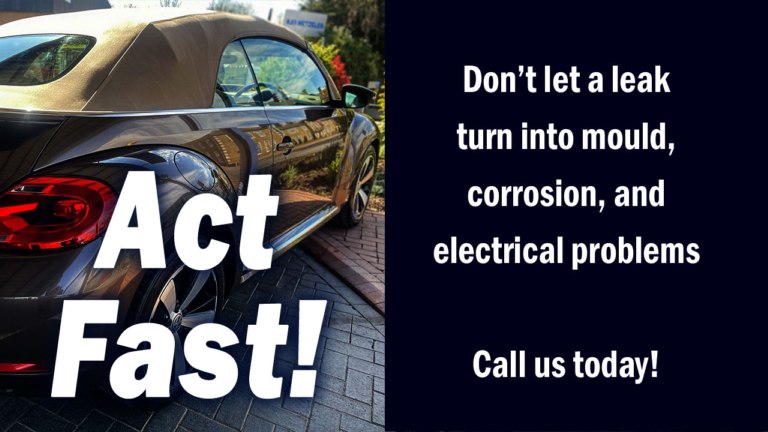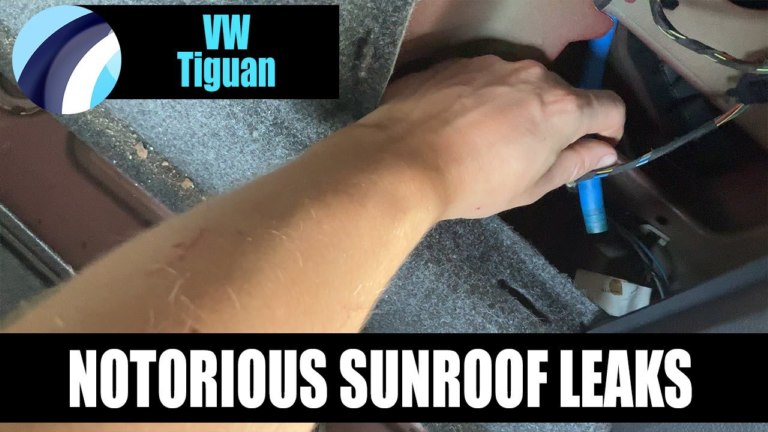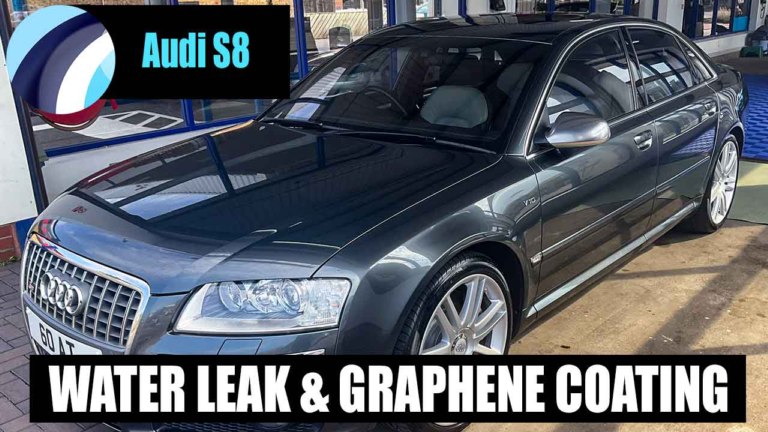How To Dry Carpets In A Wet Car

This video is to help those wanting a guide on how to dry wet carpets in cars. This is a Vauxhall Corsa which had a leak around the pedal seal.
Sometimes cars have leaks through perished seals, blocked pipes or incorrectly fitted windscreens. Although you can quite easily repair rain water leaks, you might be left with a car full of water. Water in a car can result in electrical problems, mould and nasty odours, so it is important to thoroughly dry and decontaminate the car with antibacterial/microbial.
Unless you have one of these small town cars which can have very thin carpets, it is unlikely you can dry your car without removing the door rubbers and tread plates and lifting the carpets, so you can remove any water which has pooled into the foot wells. Lifting up the carpets also lets air circulate while water can drain out of them, otherwise they are just sitting in a puddle. On some cars with thicker carpets, it might even be worth removing the seats, or in some cases, removing the wet carpet from the car completely, so you can hang it up to dry.
If you leave the carpets wet, you will end up with damp problems, there will be condensation on any cold hard surface. The water will help mould and bacteria to grow, it will smell and eventually cause a health hazard. Corrosion to the bodywork and damage to electrical units can become very expensive if not dealt with properly.
Here are some steps you can take to dry your car carpets.
Assess how much water is under the carpets.
Before you can begin, you need to know how much water is in the car. Most people have smelt a damp smell, had steamed up windows and eventually notice damp carpets. Often they assume that as the surface of the carpet is only damp, that there is only a little bit of water and the carpets will dry out fairly easily.
Remove the trim around the bottom of your doors, the tread plate and pull the carpet up and aside and look underneath. You might actually find a puddle on the floor, otherwise give the foam or felt a squeeze.
Do this on both sides of the car, front and back because not all cars are the same. Usually water under the carpets can flow from front to back fairly easily, so both will be wet to some extent, but not always. Also check under the boot carpet to see if there's any water there.
Find a suitable location to dry your car.
You are going to want access to power, and you don't want to be rained on, so you will need to do this inside a garage. If you don't have a garage, you may need to ask if you can borrow one.
Drying your car can take a long time. We have industrial equipment to dry cars and so can dry some of them overnight or in half a day, but even with our set-up, cars which have very deep foot wells full of foam can take 2-3 days to dry.
Once you get going drying your car, you are not going to want to stop before it's dry, so allow yourself a week.
Equipment you need to dry your car.
You don't actually need heat, but heat helps. However, heaters can be dangerous if left unattended and if you are going to leave your car to dry for a few days we would probably recommend leaving a heater on, especially if you intend to put it inside the car rather than just inside the work space.
You need a blower. Moving air around will help with evaporation. It doesn't have to be super powerful as long as it's causing the air to move.
Probably the best way to remove the water, because the water needs to go somewhere, is a dehumidifier. You can use any dehumidifier but if you get those small ones out of the supermarket, they only hold about a cup full of water so you will have to be there emptying it constantly. It would be worth the money to hire an industrial dehumidifier from a hire shop.
Probably most important of all, you need a wet-vac. A vacuum cleaner which is designed to suck out water, so you can suck out the majority of the water.
You also need a disinfectant which is anti-microbial and kills mould. It is best to use one which does not contain bleach because you don't want it to bleach your carpets.
WARNING: It should go without saying that electrical devices and water don't mix. If your car's floor is full of water, don't sit a heater in it. Be sensible, follow the manufacturers instructions on any and all equipment you use.
Take the seats out of the car.
We usually recommend taking the seats out of the car so that you can lift the carpets out to get underneath. This is typically just a matter of a few bolts and then unplugging any cables.
Once you have unplugged any cables, do not turn the ignition on because the car's CPU will look for sensors in the seat and when it doesn't find them it will give you a warning light. You might get this anyway, and it requires that a computer be plugged into the car to reset the warnings. Most garages can do this, but it might be something you wish to avoid altogether if your car is already suffering electrical problems, which damp cars are prone to do.
Lift up the carpet.
With the seats out, you can now lift up the carpet all the way to the centre console. Use bungees or rope to keep the carpet lifted up. You might be able to use woodworking spring clamps to grip the carpet if there are no holes through which to pass a hook.
There might be a thick rubber piece of carpet underlay beneath the driver's feet. This has foam on the underside and might also be wet. You can lift this up by wedging something underneath.
Now use your anti-microbial product while the car is still wet. It will disinfect all that dirty water and find it's way to everywhere it's been. If you dry your carpets and then spray on disinfectant, you are just making the surface wet again, and it won't be able to penetrate. Use rubber gloves from now on.
Once the carpet it lifted up, it will already begin to drip-dry. This will continue as long as it is held up, water will find its way to the lowest point. You might want to wait a little while for most of the water to drip out into the floor pans, then suck it all up. You will already have collected the majority of the water.
Next, you can use the wet-vac to extract water from the foam carpet underlay. You can give it a squeeze and try and force water out, but be careful with the type of felt shown in the video above. It can be quite delicate and come apart easily.
With the worst of the water sucked out of your carpets, point your blower in the direction of the car and turn on the dehumidifier. They don't have to be inside the car, if you have your car in an enclosed garage, having them next to the car will be enough. Those carpets if lifted up will be drip-drying from the bottom and just a little air movement will help the carpets dry on top.
Now, just be patient. Check back every few hours, empty the water in the dehumidifier -- you will soon learn how often you need to be checking back.
For the first few hours, with any luck, most of the water will have dripped from the carpet into the floor pans or be collecting at the lowest points in the carpet underlay. You should find the highest parts are beginning to dry, while the lowest points are now really soggy. Don't be afraid to use the wet vac again and suck out any water that you can easily get to.
Check your carpets are dry.
It's impossible for us to say how long this will take because it depends on so many factors. But be patient and don't stop until you are sure your carpets are bone dry.
Once you are confident that they are, you can put the car back together again. We'll keep our fingers crossed for you that this is the end of your problems.
If all this sounds a chore, you are probably right. So you don't want to find you have to do it all over again. Before you go down this route, make sure you have fixed all the leaks in your car. As we have said many times, leaks are often caused by seals, grommets and rubber washers getting old and shrinking, so they let in water. All those bits of plastic in your car are the same age, so there is a good chance that if one thing starts leaking, something else might also be causing a leak. Make sure you check them all, replace them and reseal them before trying to dry your carpets.
If you would like to know more, please see our Carpet Drying Services.
We fix leaks and dry cars
Anyone can fix a leak, but you are still left with a wet car, which is the real problem. That is why we provide a complete service, decontaminating and drying your car so that you don't have to deal with mould and electrical problems later.
Water Leak Repairs
Related Videos
Here are some more of our latest #CarWaterLeaks videos
VW Tiguan Sunroof Leak
The VW Tiguan, Skoda Yeti, and other Volkswagen and Audi Group vehicles are somewhat notorious for their leaking sunroofs.
Watch VideoAudi S8 2008 | Water Leak & Graphene Coating
This car came to us because water was dripping from the lights in front of the sunroof, and left us with a graphene coating!
Watch VideoA Negative to a Positive | Range Rover Water Leak
This is an excellent example of a problem car and how everything worked out splendidly in the end.
Watch VideoHow to manage a leaky car
While we recommend getting rain water leaks fixed and your car dried, it isn't always possible to do so right away. So in this video we discuss how you can manage a car with a water leak.
Watch Video
Can We Help You?
"We can offer specialist advice on the best car service to suit your requirements"
When bringing your car to New Again, we often ask you to explain exactly the reason for having your car Protected, Valeted or Repaired. Once we understand exactly what it is you are trying to achieve, we will appraise your vehicle using our detailed appraisal check-sheet allowing us to identify areas of concern and tailor specific services that match your requirements and budget.
If you are not sure what service you need and would like to speak to one of our technicians, simply request a callback by filling in the form on our contact page.





Share this blog